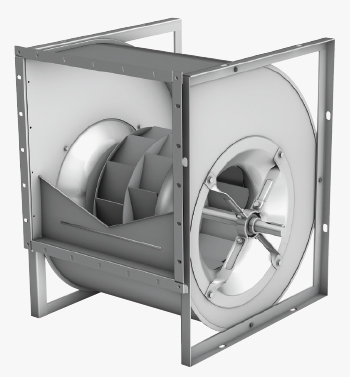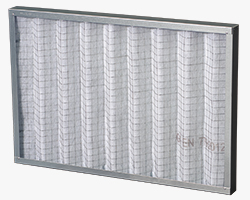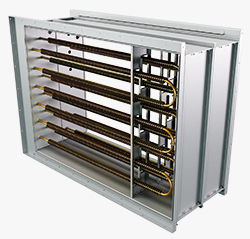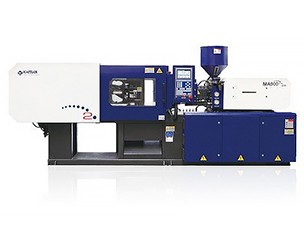
Sections
SECTIONS
Fan section types: | |
|---|---|
| |
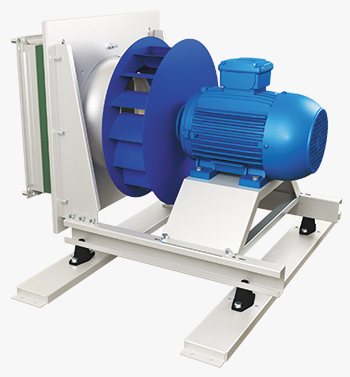 |
Plug fan Plug fans are used in case of low or medium air performance and pressure. Direct driven motor and backward curved impeller ensures high performance, reliability and easy maintenance due to the absence of belt drive. The impeller is made of high-strength composite material or sheet steel with protective polymer coating. For correct fan operation, soft start, active thermal protection and smooth speed control, it is recommended to use variable frequency drive. It can be supplied loose or mounted inside the fan section as an option. Motor and impeller are isolated from section housing with rubber antivibration mounts and flexible duct connectors. The engine complies with energy efficiency classes IE1, IE2, and IE3, depending on the project requirements. As an option fan can be provided in EX-proof execution. |
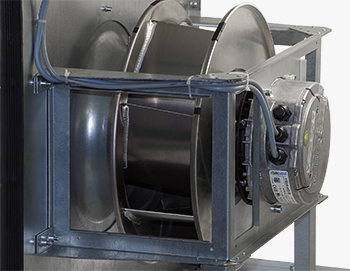 |
Plug fans with electronically commutated motors (EC motor) Plug fans with the EC motors are used for projects that require high energy efficiency. The advantages of this type of fan are: extremely low power consumption at any speed, no need for external speed control and compact size due to motor with external rotor. |
|
|
Belt-driven fans For units that require high pressure and airflow it is recommended to use belt driven fans in spiral housing. These fans are available with backward or forward curved blades. Belt-driven fan with run and standby motors are available as an option. The fan and gear blocks are located on the single frame, which is separated from the body of the machine with anti-vibration mounts. The engine meets IE1, IE2, and IE3 energy efficiency classes, depending on the project requirements. |
Sound attenuators | |
|---|---|
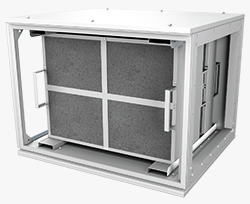 |
Silencer unit consists of easily removable sound-absorbing 100 mm thick panels, with the length of 600 mm or 1200 mm. Noise absorption in accordance to ISO 7235. Sound absorbing panels have two types of execution: pointed with reduced resistance and rectangular with a larger area of absorption. Panels are made of high density mineral wool with protection felt cover. The distance between the plates:
|
Air filters | |
|---|---|
|
|
Units include the following filter elements:
All filters have easily removable cassettes that can quickly and easily be replaced. In the case of two stages of filtration, unit contains a compact section in which panel and bag filters are installed close to each other. |
Electric heater | |
|---|---|
|
|
Section consists of electric tubular heating elements (heaters) with spiral fins with heating capacity of 5 kW each. Heating elements in the required amount are set in a removable cassette frame of galvanized steel. Heaters are protected from overheating by thermal switches with automatic reset at 50 °C and with a manual reset to + 90 °C. Heaters are grouped in «triangle» scheme, three heaters in each group. Groups of heaters are then connected in parallel into 380 V power supply network.
Option: Unit with built-in electric heater triac controller allows keeping the supply air temperature on a set level with accuracy of ± 1 °C.
Recommended accessories: Fan Pressure switch DTV 500 - additional protection from overheating in case of low air flow. The sensor can be pre-mounted inside unit, or supplied loose as a separate item. External Triac controller RNS - provides smooth control for heaters up to 75 kW (25 kW triac + two steps to 25 kW). |
Water cooling coil - DX cooling coil - LPHW heating coil | |
|---|---|
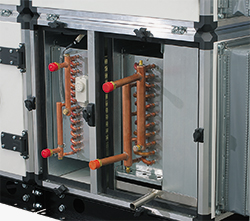 |
Water cooling coil Heat exchanger complies with EN 13053, EN 1216 Unit consists of copper tubes with aluminum finning. Section is equipped with a removable drain pan. For water or glycol mixtures up to 50% glycol concentration. Maximum working pressure of the cooling medium is up to 16 bar (1.6 MPa). Drain and air bleeder valves are provided for each coil.
Recommended accessories: Three-way valve with electric actuator.
DX cooling coil Complies with EN 13053, EN 1216 Copper tubes with aluminum finning. Section is equipped with a removable drain pan made of stainless steel. For refrigerants R22, R407, R410A, and others. Drain and air bleeder valves are provided for each coil.
LPHW heating coil All heaters comply with standards EN 13053, EN 1216. Heat exchanger consists of copper tubes with aluminum finning. Maximum temperature of heating fluid: 150 °C. For water or glycol mixtures up to 50% glycol concentration. Maximum working pressure of the heat transfer fluid is up to 16 bar (1.6 MPa). Drain and air bleeder valves are provided for each coil.
Recommended accessories: Thermostat F3000 protects the heater from freezing. The thermostat can be pre-mounted on the coil, or supplied as a separate item. Mixing set USWK. |
Rotary heat exchanger | |
|---|---|
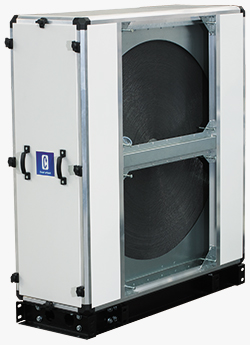 |
A rotary heat exchanger is a rotary honeycomb matrix with layers of aluminum ribbon, which is slowly rotated within the supply and exhaust air streams. As the wheel rotates, heat is picked up from the exhaust air stream in one half of the rotation and given up to the fresh air stream in the other half of the rotation. Thus waste heat energy from the exhaust air stream is transferred to the matrix material and then from the matrix material to the fresh air stream, raising the temperature of the supply air stream. The advantages of a rotary regenerator are: high efficiency, keeping comfortable humidity and low risk of frosting. Rotary regenerators in AirVENTS units made of two types:
|
Plate heat exchanger | |
|---|---|
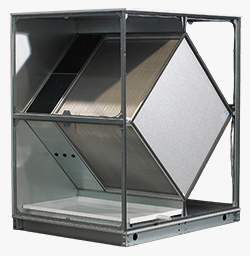 |
Heat exchanger where heat is transferred from the flow of exhaust air to the incoming air from the street. Heat exchanger is made of profiled aluminum plates, packed with elastic heat-resistant sealant. The sealing provides a reliable separation of the supply and exhaust air, eliminating internal flows, and not allowing moisture, dirt, odors and microorganisms transfer between streams. To avoid frosting heat exchanger provides active protection by means of the bypass channel. Drain pan is installed under the heat exchanger. |
Thank your for your time and your wish to improve our site.


